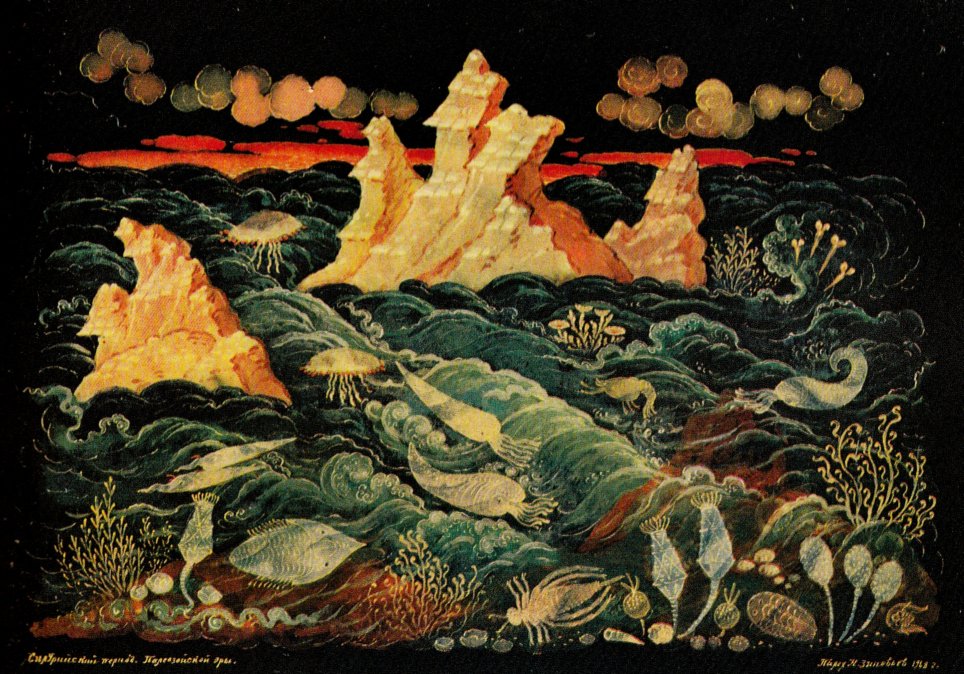1.4: Filling Marine Ecosystems
- Page ID
- 49649

This happened during the Cambrian and Ordovician periods, which jointly continued for almost 100 million years. Most of this time the Earth climate was relatively warm, but continents were concentrated in the Southern hemisphere. At the end of Ordovician, Africa hit the South Pole, and this resulted in a serious glaciation.
The sea, in large degree, prevailed over the land and thus created exceptionally favorable conditions for the development of marine communities, which in this epoch became finally similar to what we see around now. For some groups, there was not “enough space” in the sea, and, as a consequence, the colonization of land from higher organisms started.
At this time, all main types and even classes of invertebrates and vertebrates and terrestrial plants already existed. Stromatolites went to the “background” of ecosystems and were replaced with other builders of bioherms (reef-like organic structures) like archaeocyaths (Fig. 2.2.13, group probably close to the sponges) and calcareous red and green algae. Archaeocyaths went extinct at the end of the Ordovician, but calcareous algae have survived.
In Cambrian, there was a great variety of different groups of animals, usually small size and with a skeleton of different types (phosphate, calcareous, organic): that was a consequence of “skeletal revolution”. some of them were crawlers, some swimmers, and some burrowers.
Among the seafloor bilaterians, trilobites (an extinct group of arthropods) dominated, there were also many other groups of arthropods and lobopods (intermediates between ecdysozoan nematode-like “worms” and arthropods), plus various spiralians, namely brachiopods and mollusks (Fig. 2.2.21, 2.2.22) including cephalopods which played the role of pelagic predators, preceding sea scorpions and armored fish. There were also plenty of echinoderms, mostly sea lilies and many other, now extinct, classes (Fig. 2.2.15). First jawless fishes (Fig. 2.2.17, top row) were also the part of pelagic life.
It can be assumed that at this time started the mass “exodus” of invertebrates to the land. Perhaps, there was already some soil fauna, consisting of nematodes, small arthropods, and other similar organisms.
Green algae were gradually replaced red algae in communities. For some of them, like for some invertebrates, there was “not enough space” in the ocean, and they proceeded to conquer the land. The living conditions outside of the ocean were much more stringent for plants than for the animals, so the process of adaptation took a long time. The first land plants are known from the Ordovician; they probably were liverworts (Fig. 2.2.10, top left). Land conquest for plants was concerted with the development of symbiosis with mycorrhizal fungi (Fig. 2.2.5). Apparently, among the first terrestrial photosynthetic organisms were symbioses, both with a predominant fungus and predominant alga. The first gave rise to the lichens, who took the most extreme habitats, and the second to the contemporary terrestrial plants.
Terrestrial plants had to solve many problems. There were, in particular, water supply (so they developed vascular system), gas exchange (acquired stomata), competition for light (body began to grow vertically with the help of supportive tissues), and spore dispersal (diploid stage, sporophyte, began to form sporangia on a long stalk containing spores covered with thick envelope).
A serious plant problem was also in the optimization of the life cycle. Putative ancestors of land plants, charophyte green algae, did not have any sporophyte as their zygote proceeds to meiosis almost immediately after fertilization. New sporophyte could arise in connection with the need to disperse the spores from plants growing in the shallow water, where the wind acted as the most efficient dispersal agent. First, sporophytes served likely only for the storage of the haploid spores, but later most of the gametophyte functions were transferred to the sporophyte.
It is important to note also that the colonization of the land by plants was to happen after the formation of soil, the process involved bacteria, fungi, and invertebrates. Furthermore, the term “colonization of land” is not accurate since the actual land in the usual sense in those days did not exist; it was, in fact, huge, often completely flooded this wetlands-sea bottom space, interspersed with rock formations; there were no permanent freshwater. We can say that animals and plants made the land themselves, stopping erosion that once ruled the earth’s surface. Land type familiar to us was formed slowly; we can, for example, assume that until Jurassic watersheds were completely devoid of vegetation.


